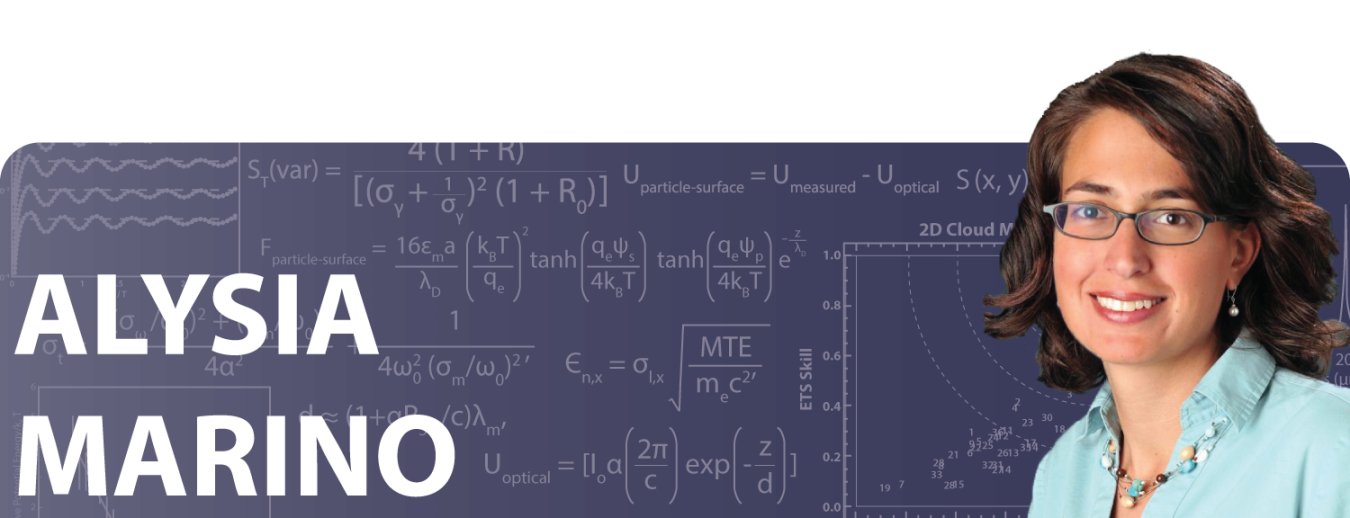Marino studied the properties of neutrino interactions in water and improved scientists’ understanding of neutrino fluxes generated in beamlines.
February 7, 2020
WHAT DID THE 2010 EARLY CAREER AWARD ALLOW YOU TO DO?
Neutrinos, one of the fundamental building blocks of our universe, are elusive particles. Though abundant in nature, with no electric charges and tiny masses, neutrinos interact very rarely, making them a challenge to study in the lab. Over the past 20 years, we have obtained compelling evidence that neutrinos can change from one type to another as they travel through space.
Initially, these discoveries relied on neutrinos produced in the upper atmosphere or in the Sun. But more precise measurements of neutrino properties require man-made sources, such as neutrino beams produced from particle accelerators.
This Early Career Award supported a measurement of the properties of neutrino interactions in water (important for the Super-Kamiokande detector that serves as the far detector for the T2K long-baseline neutrino oscillation experiment). The support allowed us to improve our understanding of the fluxes of neutrinos generated in neutrino beamlines, such as the proposed Long-Baseline Neutrino Facility (LBNF) that will use accelerators at Fermilab to provide the world’s most intense beam of neutrinos for the DUNE experiment.
ABOUT:
Alysia Marino is an associate professor in the Department of Physics at the University of Colorado Boulder.
SUPPORTING THE DOE SC MISSION:
The Early Career Award program provides financial support that is foundational to young scientists, freeing them to focus on executing their research goals. The development of outstanding scientists early in their careers is of paramount importance to the Department of Energy Office of Science. By investing in the next generation of researchers, the Office of Science champions lifelong careers in discovery science.
For more information, please go to the Early Career Research Program.
THE 2010 PROJECT ABSTRACT:
Probing Neutrino Properties with Long‐Baseline Neutrino Beams
We know from other experiments that neutrinos have very small masses, come in three types, and can undergo transitions from one type to another (often called "neutrino oscillations"). This phenomenon causes the disappearance of electron antineutrinos coming from the sun and muon neutrinos produced in cosmic ray showers in the Earth's atmosphere.
However, more precise measurements of neutrino properties require intense man‐made neutrino sources, such as accelerator‐produced neutrino beams, traveling through multiple detectors at different distances. The PI proposes a research program that will center on investigating neutrino oscillations with the high‐intensity Tokai‐to‐Kamioka (T2K) accelerator neutrino experiment and will also support preliminary design work for a potential future Long‐Baseline Neutrino Experiment (LBNE) in the US. The primary focus of this project will be measurement and analysis of neutrino beam data in the T2K experiment to understand the properties of the beam, and using this knowledge to inform design choices for LBNE.
RESOURCES:
K. Abe et al. [T2K Collaboration], “First measurement of the νμ charged-current cross section on a water target without pions in the final state.” Phys. Rev. D 97, 012001 (2018). [DOI: 10.1103/PhysRevD.97.012001]
K. Abe et al. [T2K Collaboration], “T2K neutrino flux prediction.’' Phys. Rev. D 87, 012001 (2013). [DOI: 10.1103/PhysRevD.87.012001] [Publisher’s note updating the list of authors: DOI: 10.1103/PhysRevD.87.019902]
A.Aduszkiewicz, et al. [NA61/SHINE Collaboration], “Measurements of total production cross sections for π+ + C, π+ + Al, K+ + C, and K+ + Al at 60 GeV/c and π+ + C and π+ + Al at 31 GeV/c.” Phys. Rev. D 98, 052001 (2018). [DOI: 10.1103/PhysRevD.98.052001]
DOE Explains… offers straightforward explanations of key words and concepts in fundamental science. It also describes how these concepts apply to the work that the Department of Energy’s Office of Science conducts as it helps the United States excel in research across the scientific spectrum. For more information on neutrinos and DOE’s research in this area, please go to “DOE Explains…Neutrinos.”
Additional profiles of the Early Career Research Program award recipients can be found on the Early Career Program Page.
The Office of Science is the single largest supporter of basic research in the physical sciences in the United States and is working to address some of the most pressing challenges of our time. For more information, please visit www.energy.gov/science.
Sandra Allen McLean

Sandra Allen McLean (sandra.mclean@science.doe.gov) is a communications specialist for the Office of Science in the Office of Communications and Public Affairs. Sandra is responsible for identifying, curating, or creating lay-language content about Office of Science-funded research for DOE web sites, popular and trade media, and stakeholder education. She researches and writes the historical Milestone Tweets for the office Twitter account @DOEScience.
Sandra holds an associate degree in American Sign Language interpreting, a bachelor’s in science journalism and biology, and a master’s in Information Sciences. Her hobbies are sewing – especially costumes! – and lesesucht, compounded by extreme tsundoku.


